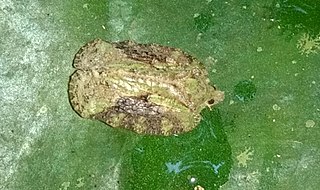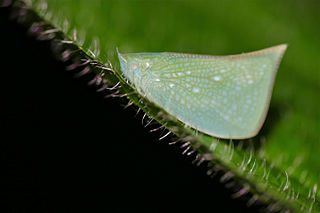
Eurybrachidae is a small family of planthoppers with species occurring in parts of Asia, Australia and Africa. They are remarkable for the sophistication of their automimicry.

Ricaniidae is a family of planthopper insects, containing over 400 species worldwide. The highest diversity is in tropical Africa and Asia and in Australia, with a few species occurring in the Palearctic and Neotropical realms. It is one of the smaller families in the planthopper superfamily Fulgoroidea.

Issidae is a family of planthoppers described by Spinola in 1839, belonging to the order Hemiptera, suborder Auchenorrhyncha superfamily Fulgoroidea.

Penthicodes is a genus of planthoppers belonging to the family Fulgoridae, subfamily Aphaeninae: found in South-East Asia. The genus name was formerly treated as feminine, but in 2022 it was revised to masculine in accordance with ICZN Article 30.1.4.4, changing the spelling of several species' names.

Gergithus is a genus of tropical Asian planthoppers in the family Issidae, erected by Carl Stål in 1870. Like all planthoppers, adults feed on plant sap and are capable of escaping by leaping. The genus like other members in the tribe appears somewhat rounded and beetle-like, in some cases, with a mimetic resemblance to ladybird beetles. Species are mostly distributed in the Indomalayan Realm.
Cromna is a genus of fulgoroid planthoppers in the family Flatidae. It was described by Francis Walker in 1857.

Siphanta is a genus of planthoppers in the family Flatidae.

Achilidae is a family of planthoppers, sometimes called "achilids" in the order Hemiptera. There are at least 520 described species in Achilidae.
Magadha is a genus of achilid planthoppers in the family Achilidae. There are at least 20 described species in Magadha.

Ormenaria is a genus of flatid planthoppers in the family Flatidae. There are at least two described species in Ormenaria.

Elicinae is a subfamily of tropiduchid planthoppers in the family Tropiduchidae, with Elica the type genus.

Dictyopharinae is a subfamily of dictyopharid planthoppers in the family Dictyopharidae. There more than 100 genera and 500 described species in Dictyopharinae.

Dictyophara is the type genus of planthoppers belonging to the family Dictyopharidae and tribe Dictyopharini, containing five subgenera. The scientific genus name Dictyophara derives from the Greek and can be translated "who wears a net".

Atracis is a genus of flatid planthopper with around 60 species distributed in the Oriental Realm and tropical Africa.
Elidiptera is a genus of planthoppers belonging to the family Achilidae.
Tropiduchus is a genus of planthoppers, recorded from Africa and Malesia.

Lawana is a genus of planthoppers in the family Flatidae, erected by William Lucas Distant in 1906. In 1923, Leopold Melichar confirmed placement of this genus in tribe Flatini and subtribe Lawanina. Species are recorded from tropical Africa and Asia.
Flata is the type genus of planthoppers in the family Flatidae and tribe Flatini, erected by Johan Christian Fabricius in 1798. Species are recorded from subtropical and tropical Asia including India, China, Indochina and Malesia.

Thabena is a genus of planthoppers in the family Issidae. There are about 15 described species in Thabena, found in southeast and temperate Asia.

Picumna is a genus of planthopper in the family Issidae. They can be found in the Southwestern United States and Central America. Picumna species are often confused with Thionia species, but can be differentiated as Picumna have four spines on their hind tibia, whereas Thionia have fewer.















